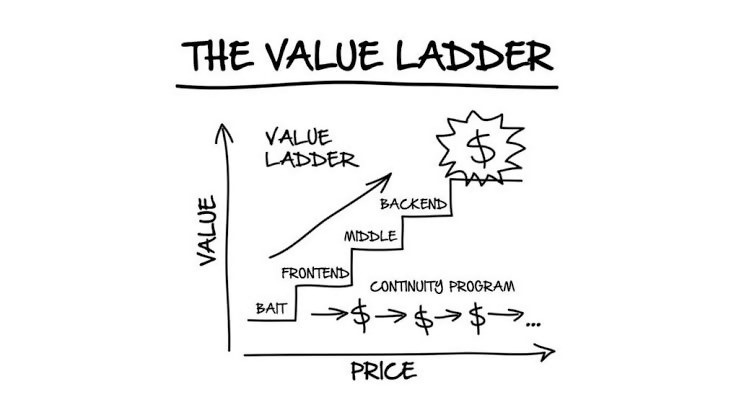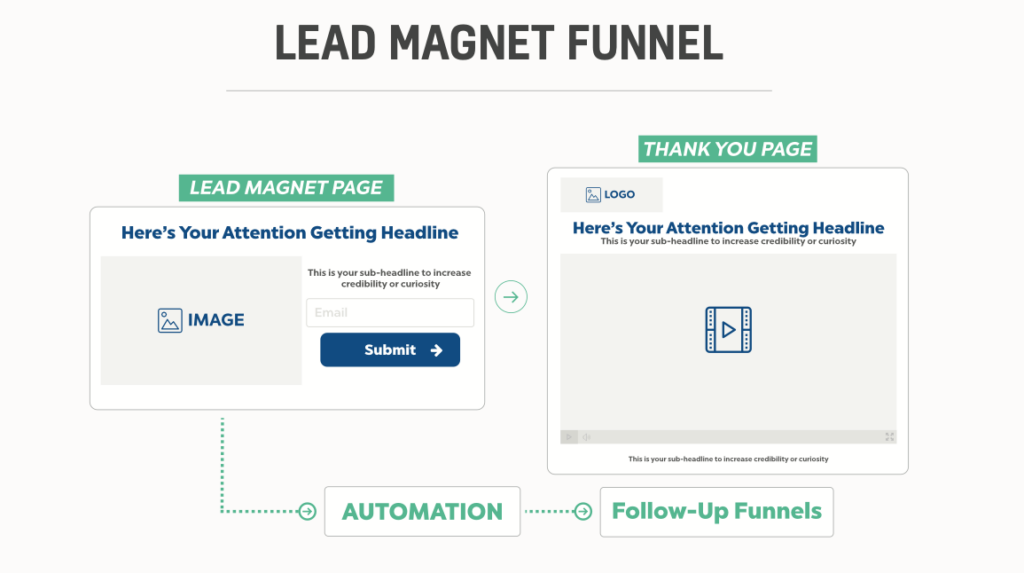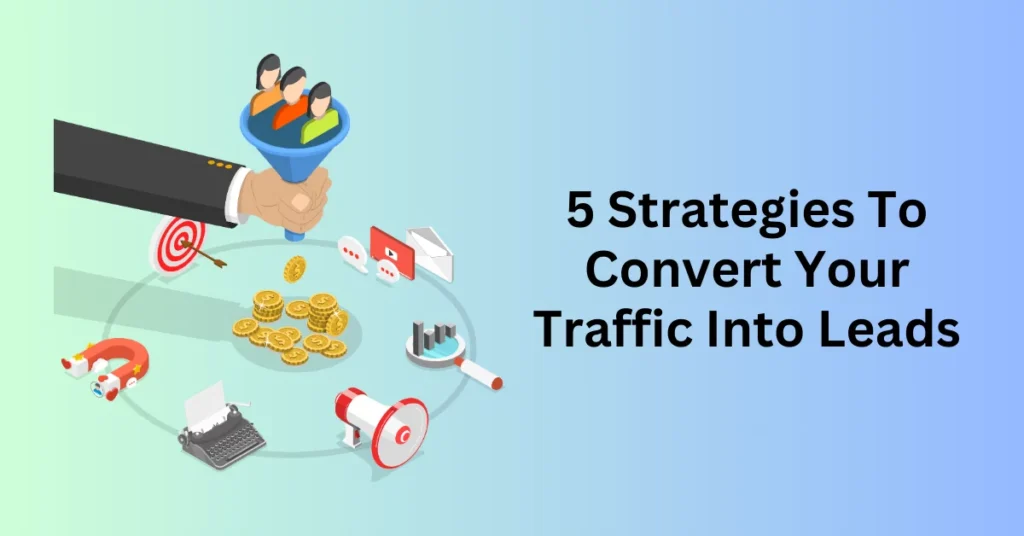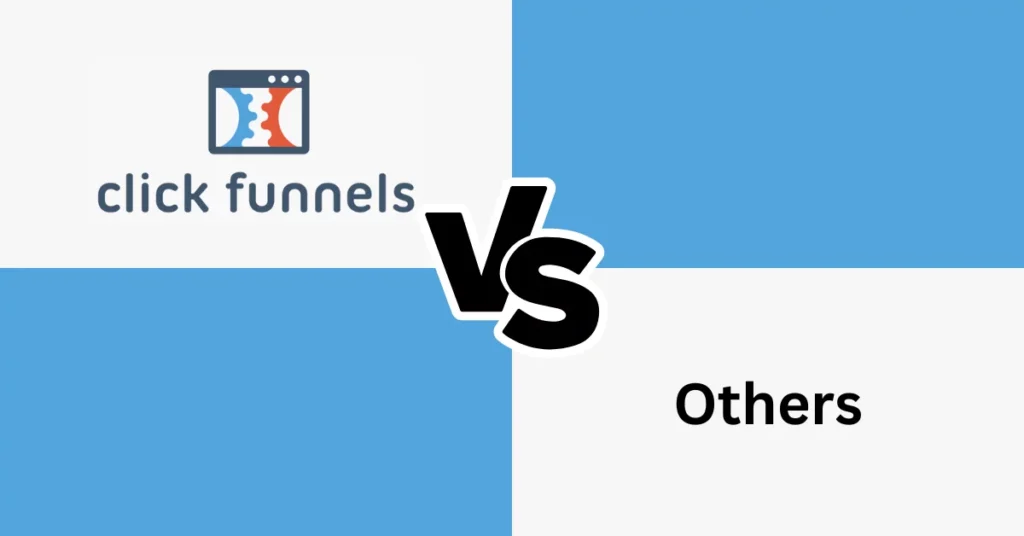In the digital age, driving traffic to your website is only half the battle. The real challenge is converting that traffic into leads—people who genuinely show interest in what you offer and are ready to take the next step toward becoming customers. Whether you’re running an e-commerce store, a blog, or a service-based business, mastering the art of lead generation is essential for sustained growth.
But how do you effectively turn casual browsers into engaged prospects? In this blog post, we’re diving into five awesome strategies that will help you do just that. These techniques, from crafting irresistible lead magnets to leveraging the power of content upgrades and newsletters, optimize your website’s performance and maximize your conversion rates.
Ready to transform your website traffic into a steady stream of qualified leads? Let’s get started!
Using a Value Ladder Sales Funnel To Convert Your Traffic Into Leads
The goal of lead generation isn’t simply to gather random email addresses. Instead, it’s about acquiring the contact information of your ideal customers so that you can guide them through a journey from potential buyers to paying customers, and eventually, loyal repeat customers. In essence, lead generation is fundamentally about driving sales.
This is why it’s crucial to approach lead generation as an integral part of your entire sales funnel. You need a structured system in place to seamlessly convert website visitors into leads, nurture those leads into paying customers, and then transform those customers into repeat buyers.
Russell Brunson has developed an effective system that accomplishes just that—the Value Ladder sales funnel. He used this very framework to scale ClickFunnels to over $100 million in annual revenue.
Value Ladder Sales Funnel

The Value Ladder sales funnel consists of four key stages:
- Bait – At this initial stage, you offer a lead magnet, something of value that entices potential customers to provide their email address.
- Frontend – Here, you present your least expensive and least valuable product or service as a way to initiate a transaction.
- Middle – In this stage, you offer a higher-priced and more valuable product or service to the customer.
- Backend – Finally, you present your most premium and valuable product or service to the customer.
Additionally, it’s highly effective to incorporate a continuity program—such as a subscription service that generates recurring revenue. To further maximize your earnings, you can add downsells, upsells, and cross-sells to these core offers.
What makes this sales funnel so powerful is its ability to:
- Initiate relationships by offering free value upfront.
- Nurture those relationships by consistently delivering value through email communications.
- Build trust by progressively providing more valuable paid offerings at each stage.
As Russell explains, the Value Ladder sales funnel enables you to systematically turn leads into loyal customers by aligning your sales strategy with the customer’s journey.
We recommend starting with the basics of the Value Ladder—a lead magnet and a front-end offer. You can always expand and build out the rest of the funnel as you go.
1. Create a Super Valuable Lead Magnet To Convert Your Traffic Into Leads

One of the most frequent mistakes in lead generation is offering uninspiring lead magnets. These might have worked well in the early 2000s, but they’re far less effective today. The novelty of receiving something for free in exchange for an email address has significantly diminished. People are now accustomed to free offers, and the value proposition of such offers has become diluted.
The daily influx of emails increasingly overwhelms consumers. The prospect of downloading yet another generic eBook fails to entice them and often raises concerns about receiving endless sales pitches afterwards. With the constant stream of free offers, many people are developing “lead magnet blindness,” making it harder to capture their attention.
So, what does this mean for your lead generation efforts?
It means your dream customers won’t hand over their email addresses unless you offer them something truly valuable. The key to designing an effective lead magnet lies in creating something that your audience genuinely desires—and giving it to them for free.
Here’s what you need to focus on:
- Offer a Solution: Your lead magnet should provide a practical solution to a pressing problem that your ideal customers are facing. This problem should be directly related to the issue your frontend product addresses.
- Value Perception: Your lead magnet should be so valuable that people would willingly pay for it if you ever decided to charge. It needs to stand out as something that solves a problem in a way that feels immediate and effective.
It may seem like a lot of effort for a free offer, but remember, your lead magnet is the cornerstone of your entire Value Ladder. Getting this right is essential if you want your sales funnel to succeed.
Your dream customers will use your lead magnet as a litmus test for the quality of your paid offerings:
- Impress them with your lead magnet, and they’ll be much more likely to explore your paid products or services.
- Disappoint them with a lackluster lead magnet, and you may lose their trust—and their business—before you even have a chance to sell to them. Why would they invest their hard-earned money in your paid products if your free offer doesn’t deliver?
While it’s common to start with just one lead magnet, we recommend expanding your offerings over time. Different lead magnets resonate with different segments of your audience, so having a variety of high-quality lead magnets can significantly increase your ability to convert potential customers into leads.
2: Promote Your Lead Magnet on Your Homepage To Convert Your Traffic Into Leads
Now that you’ve created a highly valuable lead magnet, the next step is to use it effectively to convert website traffic into leads. One of the most straightforward and effective ways to do this is by prominently featuring your lead magnet on your homepage, ensuring it’s impossible for visitors to miss.
You can optimize your homepage by combining elements of a traditional landing page with those of a typical homepage. This means displaying a clear and compelling opt-in form with a strong call to action (CTA) right on the homepage, while still retaining a navigation bar for easy access to other parts of your site. This approach ensures that your lead magnet is front and center, encouraging visitors to engage with it immediately.
For example, popular personal development blogger Scott H. Young effectively uses this strategy. On his homepage, he offers a free eBook titled “7 Must Know Strategies to Learn Anything Faster.” This lead magnet aligns perfectly with the core themes of his sales funnel, as his paid offerings include his best-selling book “Ultralearning” and a comprehensive 6-week program called “Rapid Learner.”
By offering the free eBook on his homepage, Scott allows his target audience to sample his approach to accelerated learning. If readers find value in the free eBook, they are naturally inclined to explore his related paid products. This seamless transition from a valuable free offer to paid products helps nurture leads and guide them further down the sales funnel.
3: Promote Your Newsletter at the Bottom of Each Article To Convert Your Traffic Into Leads
We recommend starting a regular newsletter to share your latest blog articles with your email subscribers. The frequency of your newsletter should align with how often you publish new content. For instance, if you publish frequently, a weekly newsletter may be ideal. On the other hand, if your publishing schedule is less frequent, a monthly newsletter might be a better fit.
After setting up your newsletter, make sure to promote it at the bottom of each blog article with a prominent opt-in form. This is a prime opportunity to capture interested readers. If someone reaches the end of your article, it’s a strong indication that they found the content valuable and may be interested in receiving more similar content. This makes it the perfect moment to pitch your newsletter.
If your publishing schedule is irregular, you can still leverage this strategy. In such cases, consider sending the full blog posts directly to your subscribers rather than a traditional newsletter with links to the articles. This way, you ensure your subscribers receive your content as soon as it’s available, maintaining engagement even if your publishing schedule isn’t consistent.
4: Create Content Upgrades for Your Most Popular Articles To Convert Your Traffic Into Leads
A content upgrade tailors a lead magnet to enhance a specific piece of content. Content upgrades convert at a much higher rate than generic lead magnets because they directly relate to what the reader is already interested in. However, creating these upgrades requires significant resources, making it impractical to develop one for every article on your site.
Instead, we recommend focusing your efforts on your most popular articles. By identifying these high-traffic posts and creating super valuable content upgrades for them, you can maximize your return on investment. This targeted approach will help you convert more of your website traffic into leads, as engaged readers are more likely to opt in for additional, related content.
5: Promote Your Lead Magnet With an Exit-intent Popup To Convert Your Traffic Into Leads
A content upgrade tailors a lead magnet to enhance a specific piece of content. Unlike generic lead magnets, content upgrades convert at a much higher rate because they directly relate to what the reader is already interested in. However, creating these upgrades requires significant resources, making it impractical to develop one for every article on your site.
However, creating content upgrades can be resource-intensive, and it may not be feasible to produce one for every article on your site. To make the most of your efforts, we recommend focusing on your most popular articles. By identifying these high-traffic posts and developing high-value content upgrades specifically for them, you can maximize your return on investment. This strategic approach targets highly engaged readers, making them more likely to opt in for additional, related content.
Why You Need A Sales Funnel

Consider what typically happens when a potential customer lands on your website homepage. They’re greeted by a navigation bar filled with links, inviting them to explore. They might click around, visit a few pages, and maybe even read a couple of blog posts. Then, more often than not, they leave—possibly never to return.
How does this help grow your business? It doesn’t.
A traditional website, while informative, often fails to guide visitors toward taking meaningful action. This is where sales funnels come in. By design, a sales funnel leads potential customers step-by-step toward making a purchase. It’s a focused, intentional process.
In a sales funnel, your prospect follows a clear, structured path. First, they encounter your lead magnet. Next, they are offered your frontend product. This is followed by your middle-tier offer, and finally, your high-value backend offer.
At each stage, they make a simple “Yes or No” decision. This approach eliminates the confusion and distractions that a traditional website might introduce.
This streamlined approach is not just more effective in theory—it’s proven in practice. Our data shows that, on average, sales funnels generate six times more sales than websites. That means having a standard website might not just be less effective—it could actually be costing you a significant amount of potential revenue.
Final Thoughts: 5 Strategies To Convert Your Traffic Into Leads
Converting website traffic into leads is essential for a successful online business. To boost your lead generation efforts, consider implementing these five strategies. First, create a super valuable lead magnet. Next, use content upgrades. Then, promote your lead magnet on your homepage. Additionally, start a regular newsletter. Lastly, rethink your approach with sales funnels.
Each method is designed to capture your audience’s interest and guide them toward becoming loyal customers. The key is to offer genuine value at every step. Ensure that your visitors see the benefit of engaging with your content and trust the solutions you provide.
As you experiment with these techniques, you’ll learn what resonates most with your audience. This will help you fine-tune your approach for maximum impact. The digital landscape is always changing, but by focusing on these core strategies, you can build a strong lead generation system that drives consistent growth for your business.
Take action, start testing, and watch as your website traffic transforms into a steady stream of qualified leads, ready to convert into paying customers.


